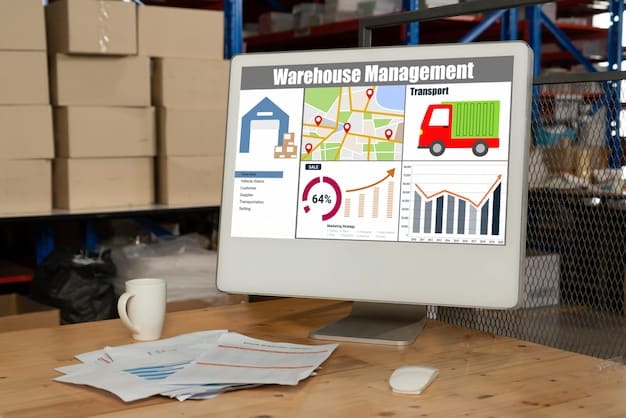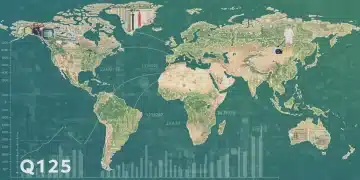Trade War Impact: Navigating the International Trade Landscape

The trade war impact on the international trade landscape has created challenges for businesses, but strategies like diversifying markets, strengthening supply chains, and leveraging technology can help navigate these changes.
The trade war impact: how to navigate the changing international trade landscape has become a critical concern for businesses worldwide. Understanding the dynamics and implications of these trade disputes is essential for developing effective strategies to mitigate risks and capitalize on emerging opportunities.
Understanding the Trade War Landscape
Trade wars, characterized by escalating tariffs and retaliatory measures between countries, have reshaped the international trade landscape. These disputes, often driven by economic and political factors, can disrupt established trade relationships and create uncertainty for businesses operating globally.
Key Players and Disputes
The trade war between the United States and China, initiated in 2018, is a notable example, involving tariffs on billions of dollars’ worth of goods. Other significant trade disputes include those between the European Union and the United States, as well as various regional trade tensions.
Economic and Political Drivers
Economic factors such as trade imbalances, intellectual property protection, and market access play a crucial role in driving trade wars. Political considerations, including national security concerns and geopolitical strategies, also contribute to these disputes.
To comprehend the overarching trade war landscape, consider the following:
- Monitoring Geopolitical Developments: Staying informed about political relations and policy changes that could lead to trade disputes.
- Analyzing Economic Indicators: Tracking key economic indicators such as trade balances, GDP growth, and inflation rates to assess the potential impact of trade wars.
- Assessing the Role of International Organizations: Evaluating the influence and actions of bodies like the World Trade Organization (WTO) in managing trade disputes.
Understanding the underlying drivers and key players involved in trade wars is essential for businesses seeking to navigate this complex environment effectively. Staying informed and adaptable allows companies to anticipate potential disruptions and develop proactive strategies.
Impact on Global Supply Chains
One of the most significant consequences of trade wars is the disruption of global supply chains. These complex networks, which involve sourcing, manufacturing, and distributing goods across multiple countries, are highly vulnerable to tariffs and other trade barriers.
Increased Costs and Uncertainty
Tariffs increase the cost of imported goods, making it more expensive for businesses to produce and sell their products. The uncertainty surrounding trade policies and regulations also makes it difficult for companies to plan and invest in their supply chains.
Relocation and Diversification
To mitigate the impact of trade wars, many businesses are relocating or diversifying their supply chains. This involves shifting production to countries not affected by tariffs or sourcing goods from multiple suppliers in different regions.

The impact on global supply chains can be further understood via the following points:
- Assessing Vulnerabilities: Identifying critical points in the supply chain that are most exposed to trade war disruptions.
- Developing Contingency Plans: Creating alternative sourcing and production strategies to mitigate potential risks.
- Investing in Technology: Using data analytics and supply chain management software to improve visibility and resilience.
By understanding the impact of trade wars on global supply chains and taking proactive measures to mitigate risks, businesses can enhance their resilience and maintain their competitiveness in the global market.
Strategies for Diversifying Markets
Diversifying markets is a key strategy for businesses seeking to reduce their dependence on specific countries or regions and mitigate the impact of trade wars. By expanding into new markets, companies can reduce their exposure to tariffs and other trade barriers.
Identifying New Opportunities
Identifying new market opportunities involves conducting market research, assessing consumer demand, and evaluating the competitive landscape. Businesses should also consider factors such as political stability, regulatory environment, and cultural differences.
Adapting Products and Services
To succeed in new markets, businesses may need to adapt their products and services to meet local preferences and requirements. This could involve modifying product designs, packaging, or marketing messages.
Market diversification can be further achieved with the following tactics:
- Conducting Market Research: Utilizing tools and resources to analyze potential markets and identify opportunities.
- Developing a Market Entry Strategy: Planning the approach for entering a new market, including identifying target customers and distribution channels.
- Building Local Partnerships: Collaborating with local businesses to gain access to networks, expertise, and resources.
Diversifying markets requires careful planning, research, and execution. By expanding into new regions and adapting their offerings to meet local needs, businesses can reduce their vulnerability to trade wars and enhance their long-term growth prospects.
Leveraging Technology and Innovation
Technology and innovation play a crucial role in helping businesses navigate the challenges posed by trade wars. From improving supply chain visibility to enhancing operational efficiency, technology can provide a competitive edge in a rapidly changing environment.
Supply Chain Visibility
Advanced technologies such as blockchain and IoT (Internet of Things) enable businesses to track and trace goods throughout their supply chains. This improved visibility helps companies identify potential disruptions and respond quickly to changing conditions.
Automation and AI
Automation and artificial intelligence (AI) can improve operational efficiency and reduce costs, making businesses more competitive in the face of tariffs and other trade barriers. These technologies can automate tasks, optimize processes, and provide valuable insights for decision-making.

Below are some specific ways technology can be leveraged:
- Implementing Blockchain Technology: Enhancing transparency and security in the supply chain.
- Utilizing Data Analytics: Gaining insights into market trends, customer behavior, and operational performance.
- Investing in Automation: Streamlining processes and reducing labor costs to improve efficiency.
By leveraging technology and innovation, businesses can enhance their resilience, improve their competitiveness, and navigate the challenges of trade wars more effectively. Embracing new technologies and fostering a culture of innovation are essential for long-term success in the global market.
Strengthening Stakeholder Relationships
Maintaining strong relationships with stakeholders, including suppliers, customers, and employees, is crucial for navigating the complexities of trade wars. These relationships can provide valuable support, insights, and flexibility in times of uncertainty.
Collaborative Partnerships
Collaborating with suppliers and customers to share information, coordinate strategies, and address challenges can help mitigate the impact of trade wars. These partnerships can foster trust, improve communication, and enhance resilience.
Employee Engagement
Engaging employees and providing them with the training and support they need is essential for adapting to changing conditions. Empowered and informed employees can contribute valuable ideas and solutions for navigating trade war challenges.
Consider some actions to take in strengthening stakeholder relationships:
- Enhancing Communication: Ensuring transparent and regular communication with stakeholders to keep them informed about developments and strategies.
- Building Trust: Fostering strong relationships based on trust and mutual respect.
- Providing Support: Offering assistance and resources to help stakeholders navigate challenges and adapt to changing conditions.
Strengthening stakeholder relationships requires proactive engagement, open communication, and a commitment to mutual success. By building strong networks of support, businesses can enhance their resilience and navigate the challenges of trade wars more effectively.
Adapting to Changing Regulations and Policies
Trade wars often lead to frequent changes in regulations and policies, which can create challenges for businesses. Staying informed about these changes and adapting quickly is essential for maintaining compliance and avoiding disruptions.
Monitoring Policy Changes
Tracking trade policies, tariffs, and other regulations requires a dedicated effort and access to reliable sources of information. Businesses should monitor government websites, industry publications, and legal updates to stay informed about changes.
Seeking Expert Advice
Consulting with legal and trade experts can provide valuable insights and guidance on navigating complex regulations. These experts can help businesses understand the implications of policy changes and develop strategies for compliance.
Key considerations here include:
- Establishing a Monitoring System: Implementing processes for tracking policy changes and disseminating information.
- Engaging with Industry Associations: Participating in networks and forums to share information and insights.
- Investing in Training: Providing employees with the knowledge and skills needed to comply with regulations.
Adapting to changing regulations and policies requires a proactive approach, a commitment to compliance, and access to reliable information and expertise. By staying informed and seeking expert advice, businesses can navigate the complexities of trade wars and maintain their competitive edge.
| Key Point | Brief Description |
|---|---|
| 🌍 Market Diversification | Expanding into new markets reduces reliance on specific regions affected by trade disputes. |
| 🔗 Supply Chain Resilience | Strengthening and diversifying supply chains to mitigate disruptions from tariffs and trade barriers. |
| 🚀 Technology Adoption | Leveraging technology like blockchain and AI to improve visibility and efficiency. |
| 🤝 Stakeholder Relations | Maintaining strong relationships with suppliers, customers, and employees. |
FAQ Section
▼
A trade war involves countries imposing tariffs or other trade barriers on each other, often in response to perceived unfair trade practices or economic imbalances.
▼
Trade wars can lead to increased costs due to tariffs, supply chain disruptions, and uncertainty in international markets, affecting profitability and strategic planning.
▼
Strategies include diversifying markets, strengthening supply chains, leveraging technology, and maintaining strong stakeholder relationships to adapt to changing conditions.
▼
Technology such as blockchain and AI can improve supply chain visibility, automate processes, and provide valuable insights for decision-making, enhancing resilience.
▼
Diversifying markets reduces dependence on specific countries or regions affected by trade disputes, minimizing exposure to tariffs and other trade barriers.
Conclusion
Navigating the trade war impact: how to navigate the changing international trade landscape demands a proactive and adaptable approach. By understanding the dynamics of trade disputes, strengthening supply chains, diversifying markets, and leveraging technology, businesses can mitigate risks and thrive in an ever-changing global environment.





